Pantech PX-600 Cellular/ PCS CDMA USB Modem User Manual UM150 HW 0612 indd
Pantech Co., Ltd. Cellular/ PCS CDMA USB Modem UM150 HW 0612 indd
Pantech >
Contents
- 1. Users Manual
- 2. Manual
- 3. User Manual
Users Manual
UM150 User’s Manual
VERIZON WIRELESS

CONTENTS
1. BEFORE USING UM150 .................................................................................1
1.1 About this User’s Manual ........................................................................................... 1
1.2 Product Overview .......................................................................................................... 1
1.3 What’s Inside the Product Package ...................................................................... 1
1.4 Introduction to Verizon Wireless UM150 USB Modem ................................ 1
1.5 Product Features ........................................................................................................... 2
1.6 Product Handling ........................................................................................................... 3
1.7 Configuration ................................................................................................................... 3
2. INSTALLING UM150 .......................................................................................4
2.1 Precautions ........................................................................................................................ 4
2.2 Recommended System Requirements .................................................................... 4
2.3 Installing Software ............................................................................................................ 4
2.3.1 Installation ...................................................................................................................... 4
2.3.2 Use of External Antenna ............................................................................................... 5
2.3.3 Warnings ........................................................................................................................ 5
2.3.4 Notes .............................................................................................................................. 5
2.3.5 Unplugging or Ejecting the Device ................................................................................ 6
3. REGULATORY AND SAFETY INFORMATION ........................................11
3.1 Regulatory Notices ........................................................................................................ 11
3.2 Operating Conditions .................................................................................................... 11
3.3 Warnings and Cautions ................................................................................................ 11
3.4 Safety Precautions ......................................................................................................... 12
4. GLOSSARY .....................................................................................................14
5. SPECIFIC ABSORPTION RATES (SAR) ..................................................18
CONTENTS

1. BEFORE USING UM150
1.1 About this User’s Manual
You will find all the information you need to install and use the UM150 in this user’s
manual. Before using UM150, you must properly install the UM150 by closely
following the installation instructions.
1.1.1 Instructions
• Install the UM150 software before inserting the UM150 USB Device into your
PC. The installation software is included in the product package. Insert the CD
into your CD-ROM drive. Installation may take a few minutes.
• It is highly recommended that you read the safety precautions described in
this manual before using the UM150.
1.2 Product Overview
Thank you for purchasing Verizon Wireless UM150 PC
USB Modem
.
The UM150 is a 3G wireless
device
that enables high-speed wireless communication
from your PC. UM150 is simple to install and use.
1.3 What’s Inside the Product Package
Following items are included in the product package. If any of the items listed below
is missing, please contact the retail location where you purchased the product.
- UM150 Wireless PC
USB Modem
- Installation CD that contains software and this user’s manual
- Quick Reference Guide
1.4 Introduction to Verizon Wireless UM150
PC USB Modem
The Verizon Wireless UM150 is designed for
PC USB port
, which is available in most
PC models. UM150 can be used to access the Internet, your company’s intranet, or
you can use it to send and receive email. It is extremely useful when you are away
from the office, on the road, or where ever a wireline Internet access is not readily
available.
1
UM150 User’s Manual
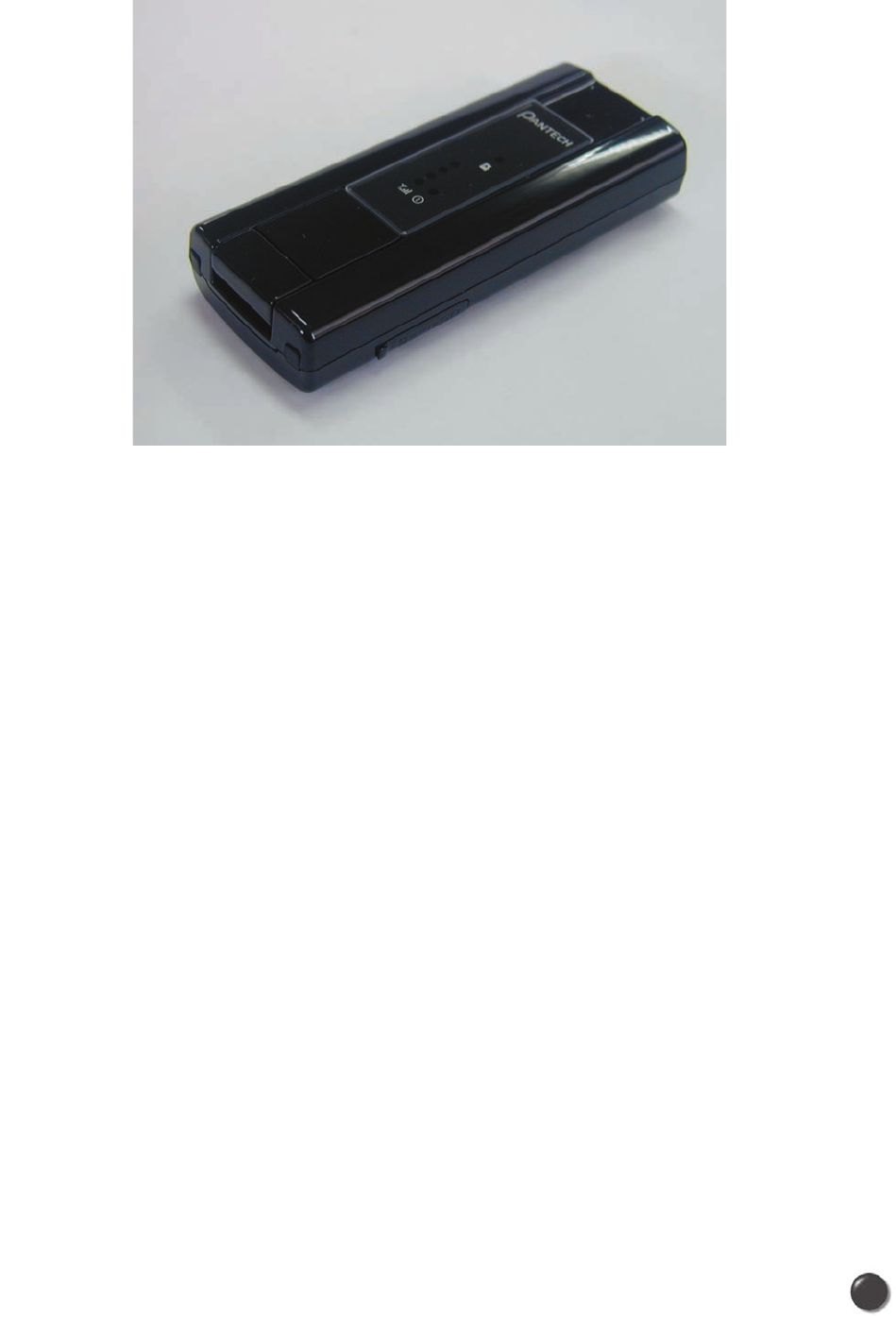
1.5 Product Features
- Power management: UM150 utilizes power management and system overhead
reduction functions provided by the USB interface for maximum power savings.
- Antenna design: Efficient, innovative design optimizes data transfer rate and
sensitivity to network signals.
- USB Modem that supports USB interface.
- Supports North American PCS (1900 MHz) and Cellular (800 MHz) bands.
- Utilizes QUALCOMM MSM6800 chip set.
- Supports 3G network technologies.
- Optimized data rate: Download 400-700 kbps; upload 60-80 kbps.
- Supports Windows 2000 and XP and Vista systems with installed host software
and driver.
- Compatible with Mac OSX 10.3.9.
- Provides Verizon Wireless BroadbandAccess and NationalAccess network
service.
3
2UM150 User’s Manual
UM150 User’s Manual

1.6 Product Handling
1) Do not put any adhesive label on the USB connector. It may leave a
sticky residue that can cause problems inside the PC USB port.
2) UM150 USB device should easily slide into the USB port.
Do not force the UM150 into the USB port as it may cause damage to
the modem and/or the port.
3) Keep UM150 in a dry and clean place.
(Storage temperature: -22°F to 149°F [- 30°C to 65°C]). Keep your
device away from liquids, dust and excessive heat.
1.7 Configuration
To use the UM150, you should install the software included in the installation CD
and configure the UM150 USB device. See the next section for more infomration on
software installation and USB device configuration.
3
2UM150 User’s Manual
UM150 User’s Manual
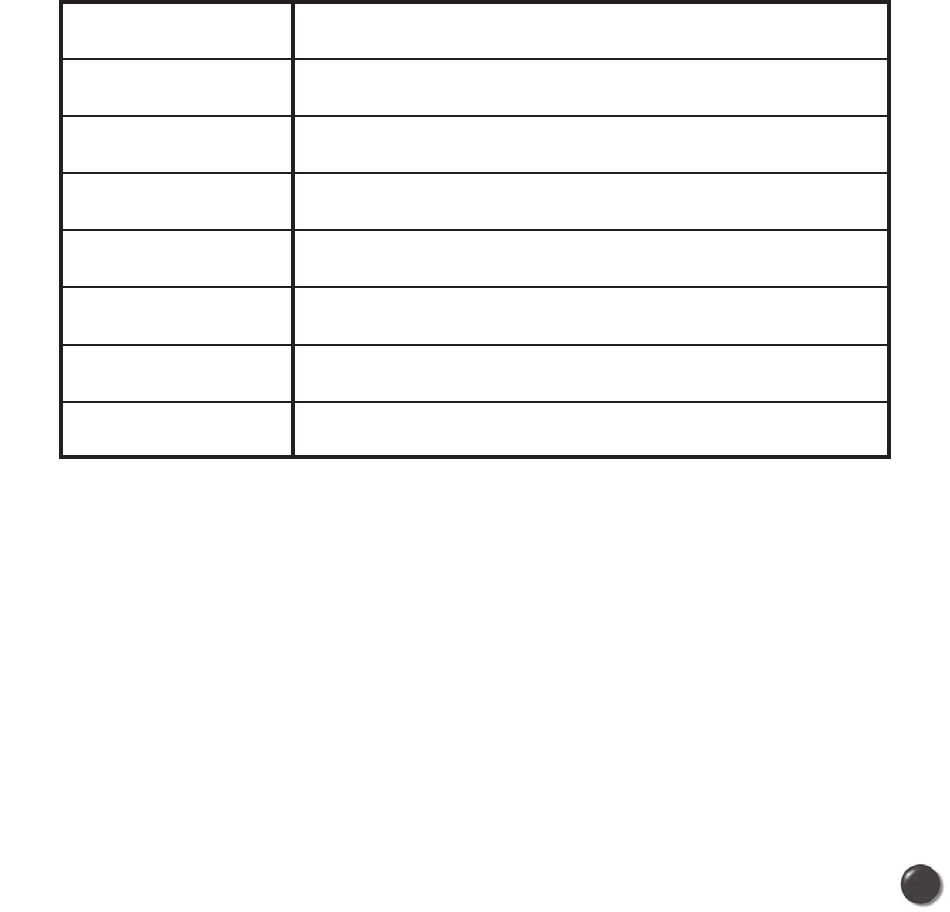
4
UM150 User’s Manual
2. INSTALLING UM150
2.1 Precautions
1) Do not insert the UM150 before installing the software in computer.
When you complete the software installation, the system will prompt
you to insert the UM150 into the USB port.
2) Once the card has been inserted into the laptop, do not remove it from
your laptop without first completing the unplugging/ejection process.
2.2 Recommended System Requirements
To successfully install and use the UM150 USB device in your PC, the following
system specifications are required.
2.3 Installing Software
2.3.1 Installation
• If you install VZAccess Manager, it will install USB Driver for UM150.
You can just follow the instruction from VZAccess Manager installation.
* UM150 is useful to Pocket PC which has USB port. Voice service is not supported.
Item
Operating system
Port
Processor
Disk drive
Memory
Disk space
Dial-up networking
Required Specification
Windows® Vista / Windows® XP / Windows® 2000 / Mac OSX 10.3.9.
USB port
Pentium 150MHz or faster
CD-ROM
32 MB
14MB
DUN bound to TCP/IP
5
4UM150 User’s Manual
UM150 User’s Manual
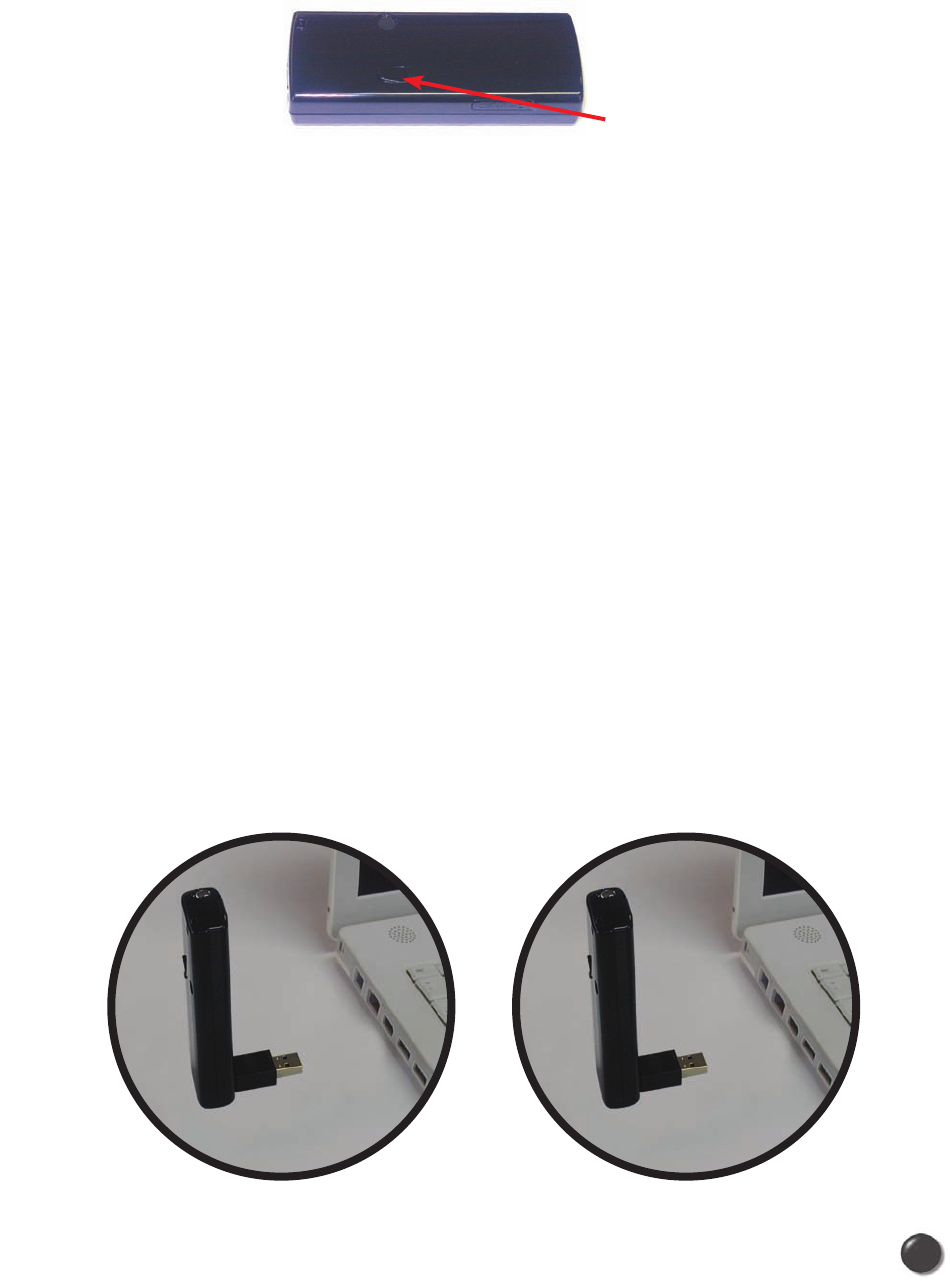
5
UM150 User’s Manual
2.3.2 Use of External Antenna Connector
• Users can use “booster antenna” independently through external antenna
connector in the weak area and it is extra purchase.
2.3.3 Warnings
• Make sure to complete the unplugging/ejection process before removing the
UM150. If you remove the device improperly, the product may be damaged.
• Before inserting the UM150 into your PC’s USB port, remove the Installation
CD from the CD-ROM drive.
2.3.4 Notes
• If you have inserted the device properly, Windows will inform you of the new
hardware. Wait for a while until Windows completes “Found New Hardware”
task. In Windows 2000, several windows similar to “Found New Hardware”
window can appear and disappear automatically. In Windows XP, several tool
tips similar to the “Found New Hardware” function will appear and disappear
in the system tray automatically. In Windows Vista, several tool tips similar to
the “Installing device driver software” function will appear and disappear in the
system tray automatically. Once hardware detection is complete, you will be
prompted to start activation.
• You hear a short beep sound each time you insert or remove the UM150,
which is quite normal. It is an audible notification that your laptop recognizes
the new hardware.
5
4UM150 User’s Manual
UM150 User’s Manual
Connect through here
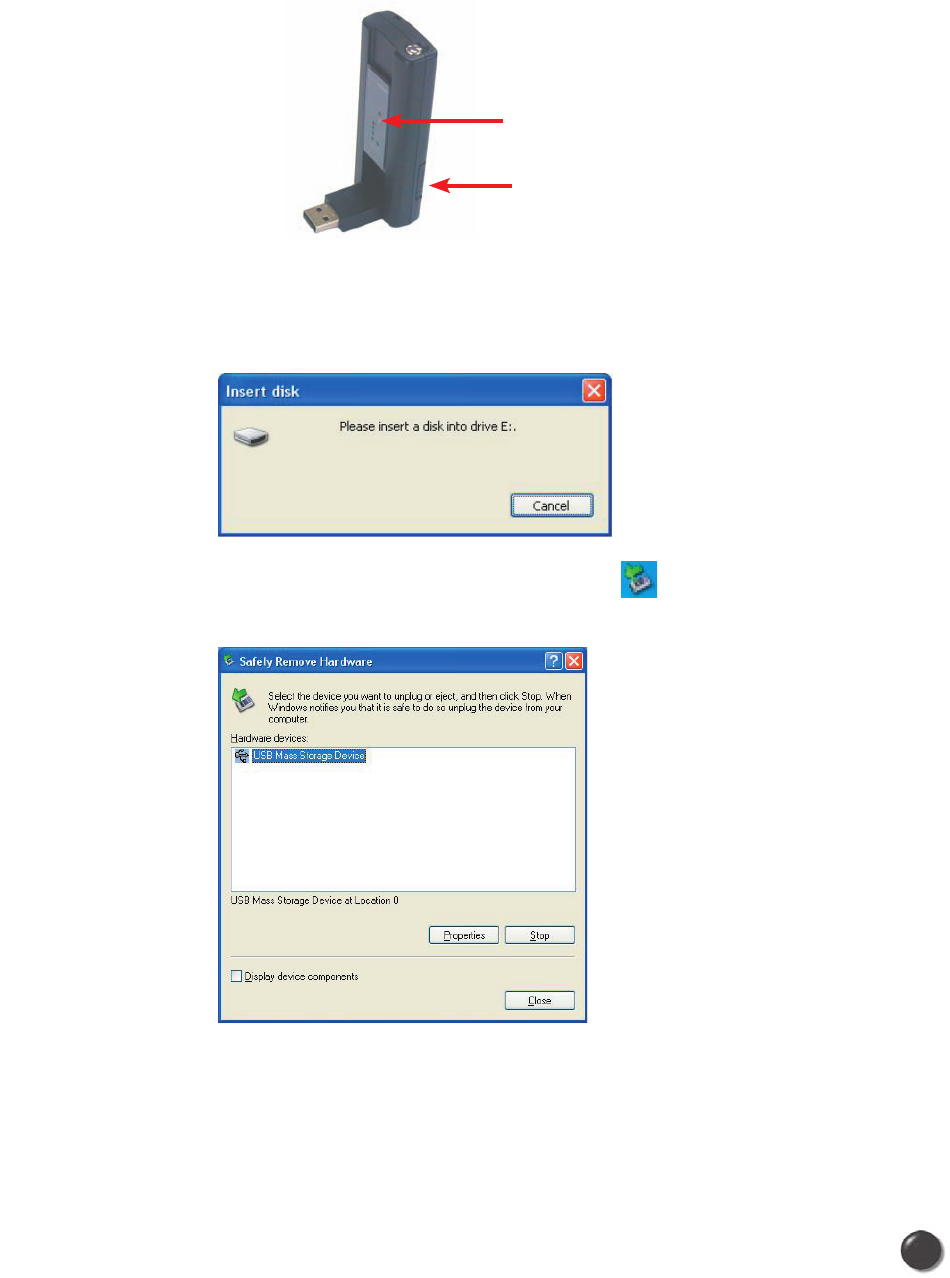
6
UM150 User’s Manual
2.3.5 Using the device as Mass storage unit
• Slide down the front window as illustrated, you can use this device as a Mass
Storage unit.
• To use this device as Mass storage unit, you must insert optional MicroSD
Card in the slot located in the right down side of this device. If there is no
microSD in the unit, following alert message will show in the screen.
While using as Mass Storage device and to eject, press icon then it will pop up
a window as when you ejecting a USB device.
• Click the [Close] button. Now, you can unplug UM150.
Slide down the front window
MicroSD card slot

7
UM150 User’s Manual
When Inserting and removing the
USB device, grip top and bottom of the modem.
• Now, you can remove the UM150 from your PC. When removing the UM150,
always grip the top and bottom of the modem and push/pull carefully.
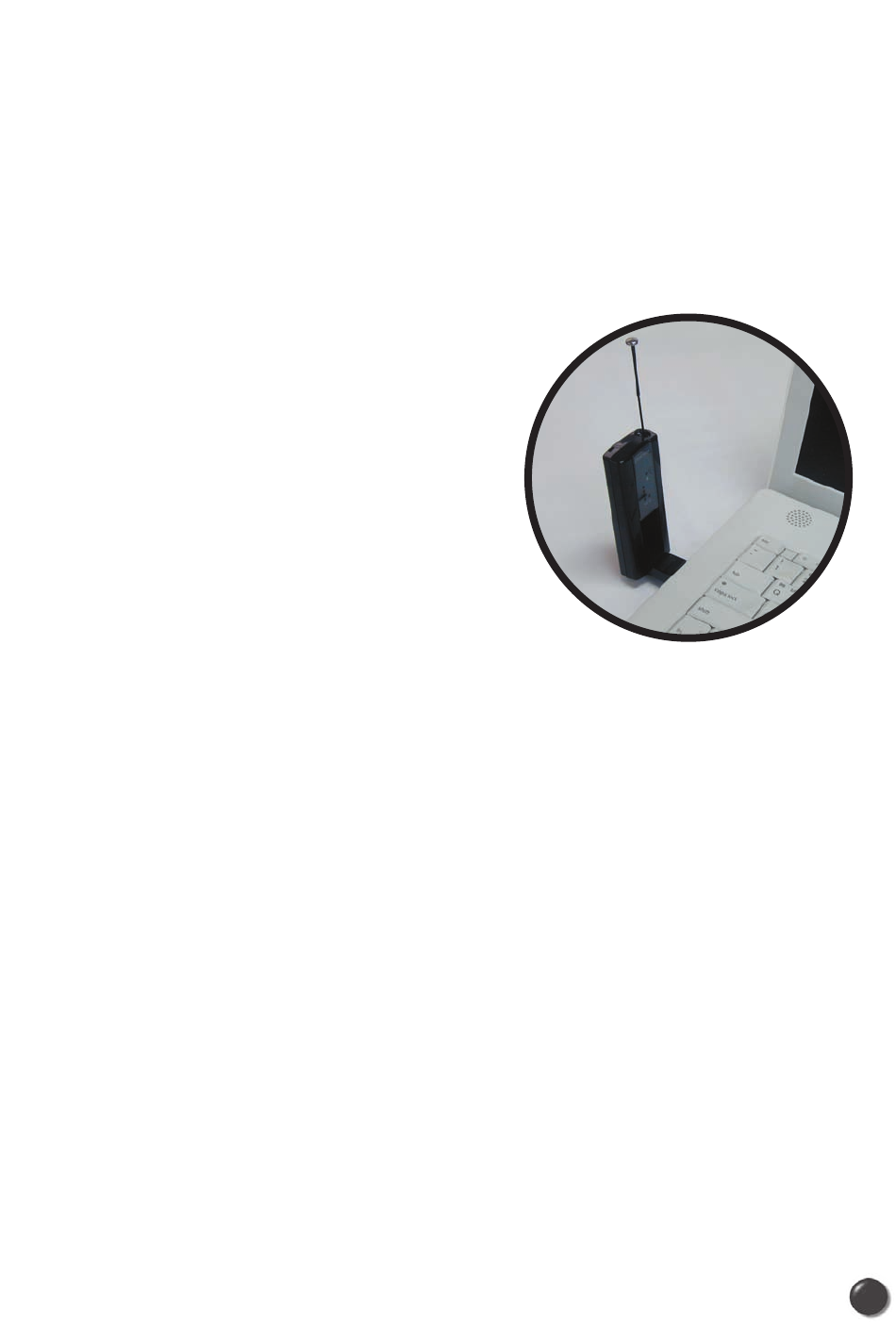
8
UM150 User’s Manual
3. REGULATORY AND SAFETY INFORMATION
3.1 Regulatory Notices
UM150 complies with Parts 15, 22, and 24 of the FCC rules. It has been tested with
the typical laptop computer with the side loading PCMCIA bay.
This USB device must not be co-located or operated in conjunction with any other
antenna or transmitter. If you use this USB device in any other configuration,
the FCC RF Exposure compliance limit can be exceeded.
3.2 Operating Conditions
1) This device may not cause harmful
interference, and this device must
accept any interference received,
including interference that may
cause undesirable operations.
2) The manufacturer stipulates that
the antenna should be more than
2.0 cm from by-standers
and 0.6 cm from the user.
3.3 Warnings and Cautions
1) Modifying or changing this USB device without express authorization
can nullify compliance with RF exposure guidelines.
2) This USB device has been tested and found to comply with the limits
pursuant to Part 15, 22, and 24 of the FCC Rules.
These limits are designed to provide reasonable protection against
harmful interference when appropriately installed.
This USB device generates, uses, and can radiate radio frequency and,
if not installed and used according to the instructions provided, it may
cause harmful interference to radio communication.
However, there is no guarantee that interference will not occur in
any particular installation.

9
3) If this USB device does cause harmful interference with radio or
television signals (determine this by turning the USB device off and
on), attempt to correct the interference by trying one or more of the
following:
• Reorient or relocate the antenna.
• Increase the separation between the USB device and receiver.
• Connect the USB device into an outlet on a circuit different from that to which
the receiver is connected.
• Consult the dealer or an experienced radio/TV technician for help.
4) This USB device does not exceed the Class B limits for radio noise
emissions from digital apparatus as set out in the interference causing
equipment standard entitled “Digital Apparatus”, ICES-003 of the
Department of Communications.
5) If you have purchased this product under a United States Government
contract, it shall be subject to restrictions as set forth in subparagraph
(C)(1)(ii) of Defense Federal Acquisitions Regulations (DFARs) Section
252.227-7013 for Department of Defense contracts, and as set forth in
Federal Acquisitions Regulations (FARs) Section 52.227-19 for civilian
agency contracts or any successor regulations. If further government
regulations apply, it is your responsibility to ensure compliance with
such regulations.
3.4 Safety Precautions
1) Data transmission and reception cannot be guaranteed because
of the nature of wireless communications. Data can be delayed,
corrupted or lost during transmission. Even though it is quite rare that
significant data delay or loss occurs if the USB device is used in a
normal manner, this USB device should not be used in cases that data
transmission or reception failure could result in damage of any kind to
the user or another party, including but not limited to personal injury,
death or loss of personal property. Utstarcom bears no responsibility
for damages or losses of any kind resulting from delays or errors in
data transmission using the USB device, or for failure of the USB
device to transmit or receive such data.
UM150 User’s Manual

10
UM150 User’s Manual
2) Do not use this USB device in areas where blasting is in progress,
where explosive atmospheres may be present, near medical equipment,
life support equipment, or any equipment which may be susceptible to
any form of radio interference. Turn of this USB device in these areas,
since it can transmit signals that could interfere with this equipment.
3) Do not use this USB device in any aircraft whether the aircraft is on the
ground or in flight. Make sure to turn off this USB device in aircraft.
If used in aircraft, it can transmit signals that could interfere with
various aircraft systems.
4) Do not use this USB device while driving a car, since it can distract
driver’s driving. In some area, using the communication device while
driving a car is illegal.
* WARNING: This product contains a chemical known to the State of
California to cause cancer.
* WARNING: This product contains a chemical known to the State of
California to cause birth defects or other reproductive harm."

4. GLOSSARY
NationalAccess
Analog Coverage
An area where analog service is available. Analog phones usually indicate signal
strength on an indicator in the phone's display when receiving an analog signal.
Browser
The software that allows you to view the Internet; contains navigator commands
such as forward and back; such as Netscape, Microsoft Explorer. A Web browser
in your computer requests HTML files from Web servers; takes you to the
Internet sites you wish to visit, by linking your computer's IP address to a site's IP
address.
COM PORT (communications port)
A connector for a communications interface, usually, a serial port.
Data
Information kept in databases, on an intranet, on the Internet, etc.
Data-Capable Digital Phone
A digital phone capable of processing data calls. Data calls may include
accessing the Internet by launching the browser within the phone or using the
phone as a wireless modem to access the Internet, or sending and receiving
email and faxes while the phone is connected to the serial port of a PC or PDA.
Digital Coverage
An area where digital service is available. Digital capable phones indicate a "D"
on the phone's display when the phone is receiving a digital signal.
Driver
Software that controls a device.
Inactivity Time-Out
A stoppage in a connection, which usually occurs after a period of time elapses,
without activity. Time-out settings are usually determined by the network.
Internet
A cooperatively run, globally distributed collection of computer networks that
exchange information via a common set of rules for exchanging data (Transfer
Control Protocol/Internet Protocol or TCP/IP). Intranet An intranet is a web site
created by a business, which posts its own company information in a secure part
of the Internet that only employees or other authorized users can reach. Intranets
are generally protected by firewalls.
11
UM150 User’s Manual

12
UM150 User’s Manual
Kbps
Kilobits per second.
Kilobyte (KB)
1024 bits (Approximately 1/2 page of plain text)
Modem
Hardware that translates and transmits data over wire-line or wireless.
Package Minutes
Package minutes are those minutes included in the cost of a monthly service
plan. Once the packaged minutes have been exhausted, additional airtime
charges apply. Please refer to Plans and Pricing for more information, details and
offers in your area.
Packet Switching
Packet-switching messages are divided into packets or pieces before
transmission over one or more routes and are reassembled at their destination.
PC-Card (PCMCIA)
The PCMCIA card is about the size of a credit card developed for devices, such
as modems, that can be plugged into notebook computers.
PDA
Personal Digital Assistant, usually a small hand-held computer used for notes,
appointments and communications.
POP3 e-mail
Protocol used by ISP's mail servers to manage e-mail for subscribers. E-mail
clients such as Microsoft Outlook support POP3.
Proxy Settings
A specific I.P. address that allows access to a secured enterprise network.
The proxy settings provide directions to a computer so that it can locate an
address and access information and services, which exist at that location.
Search Engine
A program that receives a user's search request, compares it to the entries in the
index, and returns results to help the user find relevant information.
Serial Port
A connector on a computer used to connect peripherals, which communicate
using a serial protocol.
Serial/Data Cable
A wire that connects two serial ports carrying data to one another.

Transmission Speed
The rate at which data is sent over a communications line, usually measured in
kilobits (kbps).
Tri-Mode Digital Phone
A mobile phone capable of functioning in Analog, CDMA, and PCS service areas.
The digital/web-enabled features of the phone are only functional in CDMA and
PCS service areas.
URL
Universal Resource Locator is a unique address that directs you to a specific web
site - typically starting with "WWW".
USB Cable
A wire connecting two USB ports carrying data to one another.
USB Port
A connector on a computer to connect peripherals using USB (Universal Serial
Bus) protocol.
Web Enabled
Feature on a digital handset that supports the browser function so content web
sites can be accessed.
Mobile Web
Alerts
Customized text messages sent to your wireless device, on subjects you choose,
such as weather, horoscopes, news & sports. Personalized from the Alerts tab
located on http://vzw.msn.com.
Back
Soft key that returns to the previous screen.
Bookmarks
Feature that allows you to store wireless websites for future access.
Browser
Software that allows you to view Internet content on a web-enabled device.
Customer Support
Check the balance of your bill (not available in all markets) or contact a Verizon
Wireless customer service representative.
HDML (Hyper Device Markup Language)
Computer language format used to create wireless websites.
13
UM150 User’s Manual

HTML (Hyper Text Markup Language)
Computer language format used to create desktop websites.
Microsoft.net Passport
An online service that makes it possible for you to use your e-mail address and
a single password to sign in-securely-to http://vzw.msn.com and at a growing
number of participating websites.
OK
Soft key that selects the current menu choice and advances to the next screen.
Portal
A website accessed by desktop or wireless device that provides a wide selection
of information from a single place.
Roaming
Making or receiving calls (or using wireless data services) outside your home
airtime rate area. Additional fees may apply, depending on your calling plan.
Soft Key
Left and right keys on your phone that vary in function, for menu selections.
Sync
The ability to share information (i.e., calendar, contact or email) between your
wireless device and desktop and other applications. Not available in all markets.
Time Out
After 30 seconds of inactivity on your wireless device browser, the Internet
connection is disconnected and is considered to have "timed out." The browser
session will be reinitiated when you make another menu selection, which causes
a "sending" or "receiving" message on your screen.
WML (Wireless Markup Language)
Computer language format used to create websites that can be viewed on a
wireless telephone or device.
14
UM150 User’s Manual

5. SPECIFIC ABSORPTION RATES (SAR)
Maximum: SAR 0.33 W/kg CDMA Body
SAR 0.122 W/kg PCS CDMA Body
15
UM150 User’s Manual
Mhz
824.70
835.89
848.31
Frequency
SAR (mW/g)
Chan
1013 (Low)
0363 (Mid)
0777 (High)
0.33
0.312
0.23
<CDMA Body SAR>
Mhz
1851.25
1880.00
1908.75
Frequency
SAR (mW/g)
Chan
0025 (Low)
0600 (Mid)
1175 (High)
0.089
0.122
0.111
<PCS CDMA Body SAR>
15
UM150 User’s Manual

32
SAR INFORMATION
THIS MODEL PHONE MEETS THE GOVERNMENT’S
REQUIREMENTS FOR EXPOSURE TO RADIO WAVES.
Your wireless phone is a radio transmitter and receiver. It is designed and
manufactured not to exceed the emission limits for exposure to radiofrequency
(RF) energy set by the Federal Communications Commission of the U.S.
Government. These limits are part of comprehensive guidelines and establish
permitted levels of RF energy for the general population. The guidelines are
based on standards that were developed by independent scientific organizations
through periodic and thorough evaluation of scientific studies. The standards
include a substantial safety margin designed to assure the safety of all persons,
regardless of age and health. The exposure standard for wireless mobile phones
employs a unit of measurement known as the Specific Absorption Rate, or SAR.
The SAR limit set by the FCC is 1.6 W/kg. *
Tests for SAR are conducted with the phone transmitting at its highest certified
power level in all tested frequency bands. Although the SAR is determined at the
highest certified power level, the actual SAR level of the phone while operating
can be well below the maximum value. This is because the phone is designed to
operate at multiple power levels so as to use only the power required to reach the
network. In general, the closer you are to a wireless base station antenna, the
lower the power output. Before a phone model is available for sale to the public, it
must be tested and certified to the FCC that it does not exceed the limit
established by the government adopted requirement for safe exposure. The tests
are performed in positions and locations (e.g., at the ear and worn on the body)
as required by the FCC for each model. The highest SAR value for this model
phone when tested for use at the when worn on the body , as described in this
user guide, is 1.19 W/Kg . (Body-worn measurements differ among phone
models, depending upon available accessories and FCC requirements). While
there may be differences between the SAR levels of various phones and at
various positions, they all meet the government requirement for safe exposure.
The FCC has granted an Equipment Authorization for this model phone with all
reported SAR levels evaluated as in compliance with the FCC RF exposure
guidelines. SAR information on this model phone is on file with the FCC and can

33
be found under the Display Grant section of http://www.fcc.gov/ oet/fccid after
searching on FCC ID: PP4PX-600.
Additional information on Specific Absorption Rates (SAR) can be found on the
Cellular Telecommunications Industry Asso-ciation (CTIA) web-site at
http://www.wow-com.com. * In the United States and Canada, the SAR limit for
mobile phones used by the public is 1.6 watts/kg (W/kg) averaged over one gram
of tissue. The standard incorporates a sub-stantial margin of safety to give
additional protection for the public and to account for any variations in
measurements.
SAFETY INFORMATION FOR RF EXPOSURE
Body worm operation
Near-Body operation This device was tested in multiple notebook computer
configurations with USB port configurations for typical near-body operations
with the back of the USB Modem kept 20mm from the body. To maintain
compliance with FCC RF exposure requirements it can be used in notebook
computers with substantially similar physical dimensions,construction, and
electrical and RF characteristics,and that maintain a minimum 20mm separation
distance between the user's body and the back of the USB Modem, including
the antenna. The antenna(s) used for this USB Modem must not be co-located
or must not operate in conjunction with any other antenna or transmitter
within a host device.
34
Safety Information
1 . SAFETY INFORMATION FOR FIXED WIRELESS TERMINALS
.POTE NTIALLY EXPLOSIVE ATMOSPHERES
Turn your phone OFF when in any area with a potentially explosive atmosphere
and obey all signs and instructions. Sparks in such areas could cauls e an
explosion or fire resulting in bodily injury or even death.
INTERFERENCE TO MEDICAL DIVICES
Certain electronic equipment may be shielded against RF signal from you
wireless phone. (pacemakers, Hearing Aids, and so on) Turn your phone OFF in
health c are facilities when any regulations posted in these areas instruct you to
do so. RF signals may affect improperly installed or inadequately shielded
electronic system in motor vehicles.
.EXPOSURE TO RF ENERGY
Use only the supplied or an approved replacement antenna. Do not touch the
antenna unnecessarily when the phone is in use. Do not move the antenna close
to, or couching any exposed part of the body when making a call.
FCC Compliance Information
This device complies with Part 15 of FCC Rules.
Operation is subject to the following two conditions:
(1) This device may not cause harmful interference, and
(2) This device must accept any interference received.
Including interference that may cause undesired operation.
35
U.S.A.
U.S.FEDERAL COMMUNICATIONS COMMISSION
RADIO FREQUENCY INTERFERENCE STATEMENT
INFORMATION TO THE USER
NOTE : This equipment has been tested and found to comply with the limits for a
Class B digital device pursuant to Part 15 of the FCC Rules. These limits are
designed to provide reasonable protection against harmful Interference in a
residential installation This equipment generates, uses, and can radiate radio
frequency energy and, if Not installed and used in accordance with the
instructions, may cause harmful Interference to radio communications. However,
there is no guarantee that interference will not occur in a particular Installation. If
this equipment does cause harmful interference to radio or television reception,
which can be determined by turning the equipment off and on, the user is
encouraged to try to correct the interference by one or more of the following
measures:
*- Reorient or relocate the receiving antenna.
Increase the separation between the equipment and receiver.
*- Connect the equipment into an outlet of a circuit different from that to which the
receiver is connected.
*- Consult the dealer or an experienced radio/TV technician for assistance.
Changes or modification not expressly approved by the party responsible for
Compliance could void the user’s authority to operate the equipment. Connecting
of peripherals requires the use of grounded shielded signal cables.